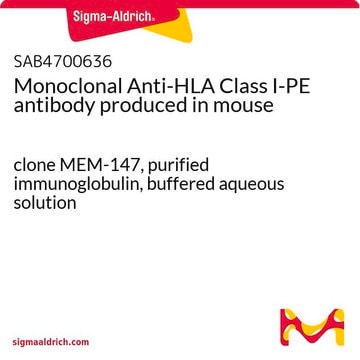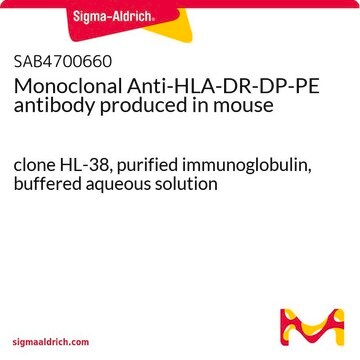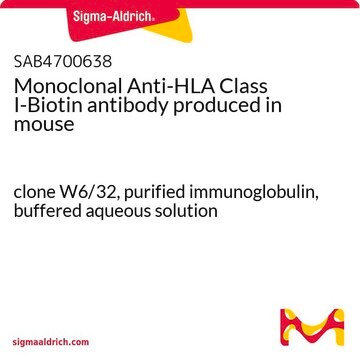F5662
Monoclonal Anti-HLA Class I Antigen−FITC antibody produced in mouse
clone W6/32, purified immunoglobulin, buffered aqueous solution
Synonim(y):
Monoclonal Anti-HLA Class I Antigen
About This Item
Polecane produkty
pochodzenie biologiczne
mouse
białko sprzężone
FITC conjugate
forma przeciwciała
purified immunoglobulin
rodzaj przeciwciała
primary antibodies
klon
W6/32, monoclonal
Postać
buffered aqueous solution
reaktywność gatunkowa
monkey, human
metody
direct immunofluorescence: 1:10 using acetone-fixed human tonsil frozen sections.
flow cytometry: 10 μL using 1 × 106 cells
izotyp
IgG2a
numer dostępu UniProt
Warunki transportu
wet ice
temp. przechowywania
2-8°C
docelowa modyfikacja potranslacyjna
unmodified
informacje o genach
human ... HLA-A(3105) , HLA-B(3106) , HLA-C(3107)
Szukasz podobnych produktów? Odwiedź Przewodnik dotyczący porównywania produktów
Opis ogólny
The previously assigned protein identifier P01892 has been merged into P04439. Full details can be found on the UniProt database.
Specyficzność
4th Workshop: code no. P1
5th Workshop: code nos. BP166, BP288, BP407, B 005
Immunogen
Zastosowanie
- flow cytometric analysis
- immunoprecipitation
- complement mediated cytotoxicity
- immunocytochemistry
Postać fizyczna
Uwaga dotycząca przygotowania
Oświadczenie o zrzeczeniu się odpowiedzialności
Not finding the right product?
Try our Narzędzie selektora produktów.
Kod klasy składowania
10 - Combustible liquids
Klasa zagrożenia wodnego (WGK)
nwg
Temperatura zapłonu (°F)
Not applicable
Temperatura zapłonu (°C)
Not applicable
Środki ochrony indywidualnej
Eyeshields, Gloves, multi-purpose combination respirator cartridge (US)
Certyfikaty analizy (CoA)
Poszukaj Certyfikaty analizy (CoA), wpisując numer partii/serii produktów. Numery serii i partii można znaleźć na etykiecie produktu po słowach „seria” lub „partia”.
Masz już ten produkt?
Dokumenty związane z niedawno zakupionymi produktami zostały zamieszczone w Bibliotece dokumentów.
Produkty
Flow cytometry dye selection tips match fluorophores to flow cytometer configurations, enhancing panel performance.
Troubleshooting guide offers solutions for common flow cytometry problems, ensuring improved analysis performance.
Końcówki do wyboru barwników do cytometrii przepływowej dopasowują fluorofory do konfiguracji cytometru przepływowego, zwiększając wydajność panelu.
Protokoły
Learn key steps in flow cytometry protocols to make your next flow cytometry experiment run with ease.
Explore our flow cytometry guide to uncover flow cytometry basics, traditional flow cytometer components, key flow cytometry protocol steps, and proper controls.
Zapoznaj się z naszym przewodnikiem po cytometrii przepływowej, aby odkryć podstawy cytometrii przepływowej, tradycyjne komponenty cytometru przepływowego, kluczowe etapy protokołu cytometrii przepływowej i odpowiednie kontrole.
Nasz zespół naukowców ma doświadczenie we wszystkich obszarach badań, w tym w naukach przyrodniczych, materiałoznawstwie, syntezie chemicznej, chromatografii, analityce i wielu innych dziedzinach.
Skontaktuj się z zespołem ds. pomocy technicznej







